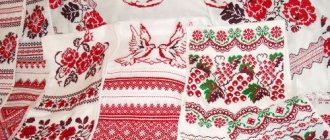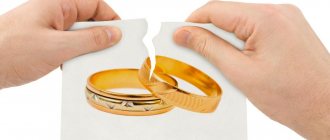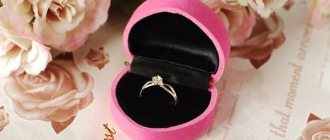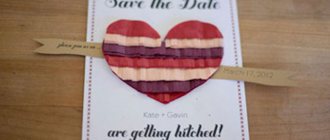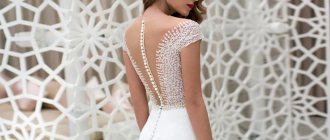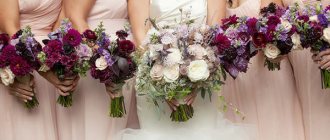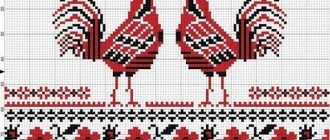What is a wedding towel and what should it be like?
The towel symbolizes the path of life, so it is present in the rituals of the beginning of the path (birth, christening), transition (weddings, getting ready for the journey) and burial (funeral). with patterns-symbols appropriate to the occasion , and decorated with ribbons, braid and lace.
The main color of the towel is white as a symbol of purity , goodness and protection against evil forces. In this design, the towel served a decorative purpose rather than an everyday one (for example, wiping hands or as a tablecloth for a table).
Embroidered towels for weddings are kept in every Slavic family.
In addition to wedding use, the ancient Slavic towel was taken on the road by military personnel and people going to work, so that good luck would accompany them on the other side . At funerals, the body of the deceased was covered with a towel or placed under his feet. As a sign of mourning, the canvas was hung on a window or gate. In addition, the towel served as a piece of clothing in the old days. Women placed it around their heads and called it “namitka.” And the men tied their belts with linen.
It has long been believed that a wedding towel is a strong talisman of family life, and it is better to make it yourself. In Rus' it was believed that it was the bride who was obliged to embroider the towel with her own hands. She seems to be embroidering a pattern for her future family life. Since girls were married off young, in order to have time to prepare everything for the wedding, relatives helped the bride with embroidery.
The fabric was taken whole , which did not consist of several pieces. The ornament was supposed to be continuous, starting from one edge and ending at the other edge, as a symbol of continuous happy life. The groom and his relatives judged the patience, skill and perseverance of the bride by the complexity and grace of the towel pattern.
This type of painting often depicts a pair of birds (doves or larks) as a symbol of love and happiness. Good wishes for the newlyweds and their names are also embroidered on the towel. Floral motifs are always as a sign of prosperity, the birth of children and happiness. The embroidery color is mostly red. This color symbolized warmth, sun and beauty.
On wedding towels there is often a traditional inscription: “Bread and salt.” In Rus' there was a custom to greet guests with bread and salt on the threshold of the house. Bread and salt mean prosperity and well-being for those to whom the loaf is served, and salt also protects against the evil eye . Guests could also bring bread and salt with them as a wish for the hosts to prosper.
The towel can be any size, but according to tradition, the width and length should be divided into seven parts without leaving a remainder. In Rus', it had a width of 35-40 centimeters and a length of 3-5 meters.
Everyone decides for themselves whether to sew a cloth for the ceremony or buy a towel for a wedding. Wedding salons offer a wide range of these items. Church shops also sell this product. The price of a towel depends on the fabric used and the complexity of the embroidered patterns and on average ranges from 300 to 5,000 rubles. But if you decide to order fabric embroidery from a professional needlewoman, then the towel will cost you even more.
Towels in wedding ceremonies
Our ancestors believed that for the wedding a girl should embroider towels and outfits with her own hands: if she did not have time, then all the women in the family helped her. Sometimes ornaments and symbols were passed down from generation to generation, the number of towels embroidered for a wedding could reach up to 40. Now everything is much simpler: one towel is needed for bandaging hands, on the second the newlyweds stand in the registry office or church, on the third they put the wedding loaf, and more The towel is needed for icons and for the Gospel.
A towel under your feet: it is believed that it is the most important thing at a wedding, because there is a tradition: whoever of the young people is the first to stand on the towel will be the master of the house. It is best to choose a towel with a floral or geometric pattern. It was believed that it was impossible to embroider on this towel a pair of doves or swans, symbolizing the newlyweds, as well as wedding symbols such as rings or flowers, otherwise everything that could be good in the lives of the young ones would be trampled by them.
Hand towel. It was embroidered by the bride herself; it is the largest and most beautiful towel that her mother presented to the groom after the matchmaking, confirming her consent to the marriage. It was obligatory to tie the witnesses crosswise with towels (nowadays they use ribbons instead of towels).
Union towel. They bandage the hands of the newlyweds in the church or registry office - this is a symbol of the strength of bonds, unity, and family happiness. On these towels one could embroider various patterns, ornaments, paintings, and write wishes for health and family happiness. Often, when embroidering towels, white and red threads were used, sometimes black was added for contrast.
Hospitable towel. A wedding loaf is placed on it, with which parents greet the newlyweds after the registry office. A pair of doves, swans or larks are embroidered on the canvas; floral ornaments are embroidered on the sides of the towel - a symbol of prosperity and well-being, flowers, trees, wedding rings.
“Bozhnik” or towel for icons. The tradition of blessing the young is still alive, so often icons in the house do not just stand on shelves, but hang in a special corner, which can be decorated with towels. Floral ornaments were embroidered on such towels; before starting work, they always prayed. These towels were different for the bride and groom: symbols like oak leaves or grapes were embroidered on the “men’s” towel, and roses and viburnum branches were embroidered on the women’s towel.
Origins of the tradition
Most folk traditions are difficult to study by folklorists and ethnographers, because all this was passed on from person to person and was rarely written down until the 18th century. Many traditions were so-called unwritten rules, and it was understood that they had to be followed, and it was not at all necessary to know the original meaning. Therefore, many such traditions were overgrown with speculation and fantasies.
The Slavs associated bread with fertility and vitality. This was the main food along with cereals, vegetables and meat; there were sayings about bread (for example, “Bread is the head of everything”). So it is not surprising that such an important event as a wedding would not be complete without this attribute. At the same time, the Slavs highly revered the sun god, which is why ritual bread received its round shape.
Magical meaning
The purpose of the towel depends on its color, embroidery and the nature of the ornament, the location of its individual elements, which in general has a magical meaning:
On the towel under the feet, on which the newlyweds stand during the wedding, there should not be images of swans, wedding rings, flowers or doves.
It was believed that young people could trample on their future happiness. The presence of floral or geometric textures is welcome.
To bless parents for the marriage of their children, patterned towels with unique bright red embroidery are chosen.
Moreover, the so-called god personifying the groom has images of grape vines and oak leaves, and for the bride, bunches of viburnum and lush roses are woven on the canvas.
The names of the newlyweds with wishes, as well as swans symbolizing fidelity and happiness, wedding rings are decorated with towels for tying the hands of the bride and groom in the registry office or church.
Here it is allowed to use any colors of threads, but the predominant color should be red, denoting love, beauty and fullness of life.
Be sure to greet the married couple with a wedding loaf with a hospitable towel.
This type of canvas is characterized by the absence of restrictions, since it can be decorated with any textures, ornaments and patterns, for example, flowers, leaves, trees, wedding rings, wishes to the newlyweds or images of animals and birds.
Thus, among the most popular symbols depicted on the towel are roses, denoting rebirth, eternity and the sun, doves, associated with peace and happiness, lilies, which are a sign of virgin beauty, innocence and purity, bunches of grapes, carrying a charge of wealth, family well-being and fertility , large families.
Tree images personify the connection between generations and clans, peacocks - renewal, development and progress, viburnum - female beauty and immortality, and the rooster symbolized health, hard work and prosperity.
How many towels do you need for a wedding?
According to ancient tradition, for a wedding you need to prepare not one towel, but several canvases. Sometimes their number could reach 40. During matchmaking, the bride gave the first towel to the matchmakers as a sign of consent to get married. It was the most beautiful and longest. The Slavs also used these embroidered fabrics to decorate wedding carts and the backs of horses.
In addition, they were presented as a gift to the groom's family . The smallest number of canvases for a wedding is five: for feet, under a loaf, for tying hands, for an icon corner in the house and for a gift from the bride to the groom’s family.
Parents always bless the newlyweds, and for this purpose there is an icon on the towel.
In addition, you need a towel for a wedding loaf. A towel under a loaf serves as a symbol of happiness and a wish for an easy family life.
Do you know what a towel looks like for a wedding under your feet? During a wedding in the church, a white towel is placed under the feet of the newlyweds. The bride and groom seem to be standing on a cloud before God and making marital vows.
This canvas is considered the most important at a wedding. No inscriptions, flowers or rings are embroidered on it, so as not to interfere with the Lord from binding the young people in sacred marriage. During the ceremony, the priest ties the hands of the bride and groom together with as a sign of unity and fidelity.
What to do with a towel after the wedding?
After the wedding, towels cannot be given to someone or thrown away if you do not want to lose a stable and happy family life. The canvases are carefully folded and stored as a keepsake of the past celebration. On anniversaries or anniversaries of marriage, they are taken out and decorated with the interior. , a loaf of bread is served on a towel .
In Rus', an elderly couple could give their wedding towel only to their children. This way the canvas could be passed on from generation to generation, especially through the female line.
After a divorce, you must decide for yourself how best to deal with the canvas. You can take the towel to church , where it will be useful for the baptism of orphans and low-income people. Or you can give it to someone who is going to perform a ceremony that will require a towel.
Towel as an attribute of matchmaking
A wedding towel is an integral element of rituals associated with the emergence of a new family. Thus, matchmaking in some regions is called giving (taking) towels, while in others it is simply called towels. The towel symbolized the girl’s consent to leave her father’s house and go to her husband’s house.
It was customary to offer bread to matchmakers on towels. In response, there were words of gratitude both to the girl herself and to her parents for giving birth to and raising such a smart girl and housewife.
We recommend reading: Why see an owl - the meaning of the sign
In Ukraine, towels were also called a betrothal ceremony. Previously, it had full legal force. The village headman took the loaf and covered it with an embroidered towel. Then the newlyweds and others participating in the betrothal placed their hands on the ritual bread. The head of the village tied the hands of those present with a symbolic knot. At the same time, important words were spoken:
«The knot is not tied, but the word is tied».
Types of towels
Today, the number of wedding accessories has been simplified, leaving 6 mandatory varieties of sacred cloth. They accompany the key moments of the wedding:
“Rukobitny” towel
It was the most beautiful, largest and was given after matchmaking from the bride’s parents to the groom as a sign of consent to marriage. Then the girl embroidered towels for her lover’s family, which were then used in the wedding ceremony.
“Blessed” towels
These were beautiful embroidered towels, which parents prepared to decorate icons for blessing before the wedding of their children. They had a lot of red embroidery on them.
Towel for wedding under feet
An important and main attribute for a wedding.
In the past, the newlyweds knelt before the priest on the wedding cloth. Today the ritual is less strict - the couple stands on the canvas with their feet. In this regard, there is a belief that drawings of doves, falcons, larks, and swans, representing newlyweds, should not be placed on it. It is believed that by stepping on birds, you can trample your cloudless future and marriage. The couple should also avoid items with hemlines and lace elements. An excellent option for a wedding would be a panel embossed with flowers, trees or geometric shapes.
Popular herbal compositions:
- hop leaves - youth, riot of joy;
- acorns intertwined with viburnum branches - fidelity of spouses;
- grapes - fertility, prosperity and wealth;
- poppy - prosperity, longevity, good health.
It is customary to keep an embroidered towel as a valuable family talisman.
"Union" towel
The priest tied the hands of the newlyweds with this towel, as a symbol of the unity and affection of the bride and groom for each other; these towels bore the inscription “advice and love,” floral ornaments, doves, swans, rings that appeared only in the Soviet years, etc. A white or union towel embroidered with white threads - for a cloudless life, for joy - with red threads.
Hospitable towel
The most famous and widespread at present. It is placed under the bread and salt with which the parents of the groom greet the newlyweds after the wedding/marriage ceremony.
The towel for the loaf is the brightest and most festive and there are no restrictions in its design. You can embroider roosters, doves, flowers, and inscriptions of wishes.
Divines
Special towels for icons, which parents used to bless their son and daughter before marriage. The groom's god was different from the bride's god.
Symbols of male strength and wealth were embroidered on the “male” towel. For example, oak and grape leaves. On the “feminine” side there are signs of fertility and the feminine principle: roses, viburnum.
Rushnik - an item of everyday and ritual purpose
Rushnik (Russian towel, rukoternik, handbrake, wiper, shelf, fly, Ukrainian towel, Belarusian towel, utsіralnik, Bulgarian rachenik, posh, rue, obrus, peshkir, testemel, chevre, Caesarea, Macedonia rachnik, peshkir, Serbian peshkir, Slovenian rocnik, Polish ręcznik, Czech ručnik, Slovak ručnik) - a towel made of homespun canvas.
The subject of folk culture and folk art of the Slavs, mostly Eastern. Buy a towel on the website -> (Shop / Household Items / Towels)
An item for everyday and ritual purposes; endowed with the semantics of path, road, connection, binding. In rituals it acts as a gift, amulet, cover, decoration, symbol of the holiday, and has a symbolic and warning function. The ritual functions and symbolism of the towel are in many ways similar to the linen (towel).
The towel is widely used in a variety of ritual situations: at funerals, weddings, birthplaces and christenings, in calendar rituals, in magic, and medicine.
In ancient times, a towel, embroidered with appropriate patterns-symbols, was an integral attribute of many rituals. Over the centuries, it has been given important figurative and symbolic meaning. Important events in the life of the people have never happened without towels. There is probably no other thing in all of decorative art that would concentrate so many different symbolic meanings.
What exactly made the towel a permanent participant in all kinds of traditions? This is partly due to the fact that the towel, due to its shape, is a symbol of the path, the road of life, which is why it was invariably used in all rituals associated with rites of passage - be it birth, christening, wedding, farewell to a long journey or burial rituals.
The white color inherent in the towel has always been associated with purity, purification, sacredness, goodness, and, consequently, protection from everything bad. This gave the towel a touch of holiness, inspired a respectful and reverent attitude, and made it a talisman and a symbol of good luck in any business. The ornaments and symbols embroidered on it carried a special meaning and deep meaning. On the other hand, in connection with this, the towel became a symbol of beauty and was widely used to decorate the interior of a home, as a part of festive clothing, etc. And thanks to its structure and natural purity, it also received wide practical use - as a hand towel or element of clothing.
Sizes of towels
According to tradition, the size of a wedding towel is divided by 7 without a remainder. The length is divided into three equal parts and the middle, one third, must be left white. Nowadays, few people adhere to this rule and choose a white canvas 2 to 3 m long for towels “under the loaf” and “under the feet”. But in the center there must be an empty space for the bride and groom to step into, and plus the rule of the design quarters of the towel, so the length in width is from 45 to 50 cm. The width of the towel is determined by repeating the pattern, and the length is determined by the amount of embroidery (the free space in the middle should be enough for the feet of the newlyweds). The towel is hemmed by hand, grasping the base thread through the cross, so that a dotted line is created on the face only if a fabric without an edge is used for it. The hem depends on the fabric, for example, calico or linen is folded 0.5 cm 2 times. The design should be symmetrical and there should be no white border on the sides. The sizes of towels “for icons” and “union” are: length from 1.8 to 2 m, and the width of the towel depends on the pattern.
Embroidery of towels for a wedding
In order to get started, you need to stock up on fabric intended for cross stitch.
You need to buy fabric about 3 m long and 50 cm wide. Basically, a wedding towel is cross-stitched. This is the most common technique for these products. This process is labor-intensive, so it is not recommended to embroider them all. The most important thing is to make the main one yourself and buy the rest.
It’s better not to start work on the eve of the wedding, but to set aside at least 2 weeks for it. It is believed that you should sit down to embroidery only in a good mood, otherwise you can bring negativity on your family.
There are many cross stitch patterns, so you can choose the one that suits you best. Each color, pattern and line has its own meaning, so it's best to become familiar with the symbolism in advance to select the characteristics that you want your family to have.
Symbols of patterns and designs:
- Oak – strength and durability;
- Poppy – feminine sophistication, large families;
- Rose – beauty, softness of heart;
- Dove – loyalty to family and spouse, love.
- Viburnum - family well-being, health;
- You can embroider some words under the pictures.
Embroidery technique
What is better to embroider on? The material used is a special fabric for cross stitch. It will need about 3 meters in length and 50 centimeters in width. To more accurately determine the required dimensions, refer to the selected diagram and drawing.
Use floss threads. Most often, preference is given to red and black colors.
The towel is embroidered in three stages: the first signifies the family tree, the second symbolizes the wishes for the newlyweds, then the beregeni come and ends with a wedding wreath with the initials of the bride and groom. It is worth considering that on one edge of the canvas it is embroidered for the bride, and on the other for the groom.
Work begins with the border. You can make real tassels, fringe, embroidered ones, or simply sew on lace. Below are various patterns for decorating the border with embroidery:
Then comes the clan tree, surrounded by various pairs of birds. The most commonly chosen species are pigeons, peacocks and swans. But you shouldn’t choose nightingales or cuckoos. The former will entail betrayal, and the latter may leave children born in marriage orphans. Several bird patterns:
The tree itself grows from a pot and has two nodes: parent and child. When embroidering, you must adhere to strict rules. The first branches symbolize grandparents; if they are directed upward, then the relatives are alive, downwards - they are dead. On the right are symbols indicating the parents of the mother, on the left - the father; the upper branches mark the grandmothers, and the lower branches mark the grandfathers. Next, on the central node, aunts and uncles are shown as dots: the older ones go from below, and the younger ones from above, the designation for women is a triangle, for men it is a square.
At the second level, symbols of parents are embroidered in the same way as they did with grandparents.
Brothers and sisters are marked with dots on the top, child node. The younger ones come from above, the older ones from below. On the right side are sisters, and on the left are brothers.
A little hint:
After the embroidery of the clan tree is completed, they begin to wish the bride or groom. Here the symbols whose meaning was discussed above are embroidered. The main motif is surrounded by small stitches of modest patterns. Below are diagrams and examples of ready-made embroideries of the most popular images:
Then they move on to the patterns of the bereginya. They are small trees in pots. But in modern times, images of crosses are more common. You need to embroider along the edges, leaving room in the center for the wedding ring. Inside you need to embroider the first letters of the name of the bride and groom.
A few examples of the bereginya and the cross:
As you can see, some are missing certain symbols, and the embroidery options are very varied. Therefore, carefully review the diagrams and combine different images. And let the towel bring into your home everything that you depicted on it.
How to decorate with your own hands?
A wedding towel, decorated with your own hands, always looks beautiful, because it takes on a special meaning for a young couple: the bride puts warmth and love into it. Quite often they are personalized, since the embroidered names on the product make it original. You can decorate wedding towels with beads. They look very solemn and elegant, while less time and effort is spent.
But many still adhere to the tradition of embroidering it with a cross, because this stitch has been used since ancient times. Today on the Internet you can find a huge number of schemes that make it easy to turn the most creative ornament or pattern into reality. You can also purchase ready-made diagrams in specialized stores. The choice remains with the craftswoman.
Tools and materials
For beginning needlewomen, it is necessary to decide in advance on the embroidery technique. These can be counted stitches - cross stitch, half cross stitch, counted stitch stitch or satin stitch embroidery technique .
According to the chosen option, the following is selected:
- fabric - usually plain, natural (linen, cotton) or mixed;
- threads - floss, special acrylic, cotton, silk threads for embroidery, less often fine wool;
- needle - (blunt-pointed needles for working with canvas and sharp for regular, densely textured fabrics);
- scissors for cutting threads;
- hoop . They are necessary when working with soft textiles. Dense, impregnated canvas allows you to work without a hoop.
Textile
In Slavic cultures, traditional handicrafts of ritual significance (rushnyks) used combinations of counted stitches and “plain” weave fabric . In such a fabric, the number of threads vertically (warp) and horizontally (weft) is the same .
If you lack skills , it is better to choose a special canvas or blank for a towel , where the main part of the canvas is smooth, and at the ends for embroidery the threads are sparse, forming a clear canvas pattern.
Important : any fabric, except special impregnated canvas, must be washed and steamed (ironed with steam) before starting work. This procedure is called decating; it ensures uniform shrinkage of textiles BEFORE embroidering.
Threads
It is not advisable to use synthetic threads for ritual embroidery . Depending on the chosen style and working technique, choose bright colors or neutral ones, close in color to the canvas. Traditional colors for a wedding towel are red and black . They symbolize love, life, joy, fertility and the earth as the basis of life.
Step-by-step instruction
For beginner craftswomen, it is better to try your hand at cross stitch.
To make the embroidery symmetrical and neat, you need to mark it . For a towel, it is better to start work from the middle. To do this, fold the selected piece of fabric (blank) in half lengthwise and smooth the fold . You can mark the middle with a simple pencil or a washable marker.
DIY embroidery. Main stages of work:
- Select a pattern. The edges (border) and part of the fabric above are embroidered on towels. Approximate sizes and possible locations of motifs are shown in the diagram. You can download the diagrams in the section below.
- Calculation of the number of repeating sections (rapports) according to the diagram. Fragments can be marked on the canvas by counting out the required number of cells. It is also convenient to draw the outline into squares of 10 cells.
- Installing the hoop
- Securing the first thread.
- Sequential creation of patterns . For a long row, stitches are first laid in one direction, and in reverse in the other direction. Single crosses are embroidered immediately.
Important : knots are not allowed in ritual embroidery! The thread at the beginning and end is secured by pulling, entwining other threads, but not with a knot.
After creating the main pattern, you need to process the edge . To do this, the fabric is folded in half and hemmed with hidden stitches. It is convenient to combine the hem with an additional decor - hemstitching.
You can use hemstitch to decorate the cross-stitched pattern on top and to separate the stripes of the ornament. Instead of decorative hemming, lace is often used at the edges .
The finished work is washed in water acidified with vinegar (this makes the color of the dyed threads more stable) and steamed.
Rules for embroidering a towel
Before you embroider a towel for a wedding with your own hands, you need to get acquainted with the rules, traditions and signs that must be observed:
- You need to start working with clean hands. Dirty hands carry negativity and bad thoughts;
- Thursday is the best day to start work;
- While embroidering, you need to drive away bad soaps;
- The embroidered design should be to your liking. This will give you strength and positive energy;
- For embroidery you need to use only natural materials; Artificial materials symbolize artificial feelings and emotions.
- You need to embroider from a whole piece of fabric, then family life will be full and correct;
- The middle of the canvas cannot be filled with a pattern. You need to leave a lot of empty space, which symbolizes the ease of family life;
- You cannot embroider straight horizontal lines above the main design. This may bring about a quick divorce;
- The towel on both sides must be the same. This is a symbol of harmony between the material and spiritual, since the reverse side is for God, and the front side is for people;
- If you make a slight mistake, you cannot correct it. This can confuse family life.
Patterns and patterns of cross stitch for wedding towels
When embroidering a towel, traditional symbols are usually selected, each of them has its own meaning. That is why the pattern must be carefully thought out, because the towel will be a talisman in the family.
Main patterns and symbols of the product:
- Water and sun are a symbol of mother and father, the elements that create all living things;
- Hop leaves are a symbol of love, passion and development;
- Viburnum clusters are a symbol of the longevity of the clan and family;
- Diamonds are a special amulet symbol, very often used when embroidering towels;
- Roses have long been considered a harbinger of love, mercy and respect;
- Grape branches are a symbol of procreation and prosperity;
- Oak is a sign of masculine strength and energy;
- Lily flowers are a sign of female innocence and purity, love;
- Two birds (pigeons) sitting next to each other are a sign of a couple.
Since ancient times, when embroidering towels, people have followed rules that will contribute to a good and happy family life.
Several rules when embroidering a towel pattern. Before you start work, you need to throw all bad thoughts out of your head, think about a happy future, and wash off the dirt from your hands. The towel must consist of a single piece of fabric.
Under no circumstances should the two halves be sewn together: family life will not work out, it will be “torn”.
The empty white part between the towel patterns should be long enough. It is believed that this way the life path of the newlyweds will be easy and happy. When choosing a pattern, you need to adhere to personal preferences. It is very important that you like the ornament. The wrong side of the towel must be done very carefully.
Embroidery pattern for a wedding towel
The variety of towels during a wedding event indicates the great ethnic role of the towel at every stage: from matchmaking to wedding. In the old days, it was believed that the bride had to embroider towels and outfits with her own hands. Once upon a time, the number of towels used at a wedding ceremony reached 40 pieces.
Today the number of towels has been reduced to 5-6:
- wedding - spreads under the feet of the newlyweds in church, registry office,
- allied towel - their hands are tied,
- “godniks” - two towels are used for icons,
- towel for the Gospel,
- a hospitable towel - a loaf is placed on it.
One of the main ones is the towel, which the newlyweds stand on during the wedding ceremony and painting. According to beliefs, it was believed that it should be long, because its length is a symbol of life together. The towel must be white; this color speaks of sincerity, honesty, and trust. Previously, they even embroidered such a towel with white threads so that life together would be bright.
The drawing should be beautiful, rich, then the couple’s life will be rich and bright. Opinions differ on the issue of the pattern of the towel, which is laid under the feet. Modern copies often contain wedding symbols - wishes, doves, rings. In the old days, it was believed that it was not worth using such symbols, because young people, when they stood on the towel, could trample on the good moments in their lives. Therefore, most often such towels had neutral motifs: floral, geometric patterns.
Patterns and patterns of cross stitch for wedding towels
When embroidering a towel, traditional symbols are usually selected, each of them has its own meaning. That is why the pattern must be carefully thought out, because the towel will be a talisman in the family.
Main patterns and symbols of the product:
- Water and sun are a symbol of mother and father, the elements that create all living things;
- Hop leaves are a symbol of love, passion and development;
- Viburnum clusters are a symbol of the longevity of the clan and family;
- Diamonds are a special amulet symbol, very often used when embroidering towels;
- Roses have long been considered a harbinger of love, mercy and respect;
- Grape branches are a symbol of procreation and prosperity;
- Oak is a sign of masculine strength and energy;
- Lily flowers are a sign of female innocence and purity, love;
- Two birds (pigeons) sitting next to each other are a sign of a couple.
Since ancient times, when embroidering towels, people have followed rules that will contribute to a good and happy family life.
Several rules when embroidering a towel pattern. Before you start work, you need to throw all bad thoughts out of your head, think about a happy future, and wash off the dirt from your hands. The towel must consist of a single piece of fabric.
Under no circumstances should the two halves be sewn together: family life will not work out, it will be “torn”.
The empty white part between the towel patterns should be long enough. It is believed that this way the life path of the newlyweds will be easy and happy. When choosing a pattern, you need to adhere to personal preferences. It is very important that you like the ornament. The wrong side of the towel must be done very carefully.
Operating procedure
I collect all the necessary materials and tools at the workplace. I pre-print the diagram on a printer so that the ornament is before my eyes.
Embroidery of a towel begins from the middle of the canvas. The pattern must be symmetrical, so I draw a central line on the diagram and outline.
If the pattern is sewn in one color, then first decide on the order: columns, rows or sections of embroidery. Try to highlight the main parts of the ornament for convenience.
On a note. Take a tour of your people's cultural museum
Pay attention to the embroidered towels. Often there are several rows with various symbolic images
So, in one product you can combine images of male strength, female luck for prolongation of the family, well-being in the family, and so on. Therefore, calculate the width of the pattern and place all the necessary elements and ornaments.
Make sure that the reverse side has a presentable appearance, so you should fasten the thread in an invisible way, for example, with a microstitch. Next, follow the pattern with a cross or using the technique you chose.
Fill the canvas sequentially. Start from the middle and work your way to the end of the fabric. Then again from the center to the edge.
Some ornaments go not only horizontally, but the frame they frame is wrapped to the length of the towel
At this point, it is important to beautifully rotate the pattern so that there are no unfinished embroidered figures
By the way, no one forces you to strictly follow one repeatable pattern. Combine several different fragments into a single composition.
Two-color patterns are best embroidered one at a time. First fill with red stitches.
After this, you finalize the black crosses on the pattern.
It is believed that errors and shortcomings in the embroidery of a towel should not be corrected. It is life itself that puts obstacles in your way. But skeptics will classify such a position as fictitious. Therefore, I leave this question to your discretion.
Historically, every girl from a young age begins to prepare a towel for her wedding. Includes all wishes for family life in the motives. Today, such cultural objects are freely sold and manufactured in factories. Although traditions oblige you to create towels yourself, free of charge, in order to invest magical power into them for a talisman. It is up to you to think and decide which way you will go: observing traditions and rules or buying at the nearest shopping center.
I would be glad if the material helped you understand the creation and embroidery of towels. Leave comments, suggestions and advice.
Tips and tricks for use
And a few more rules for embroidering a wedding towel.
- You should not throw away a towel from a loaf, nor should you give it as a gift. This can destroy family relationships and there will be no happiness in the family. The towel must be stored carefully (just as a couple treats their family).
- The towel should not consist of several pieces (only a single piece).
- It is forbidden to embroider horizontal lines above the top of the pattern - this provokes divorce and childlessness.
- Always be hands-on before embroidering the fabric (needlewomen note that this eliminates negative thoughts).
- Threads made of silk and wool are suitable for towels (only natural ones, it is better to avoid artificial ones).
- Thursday is an ideal day for embroidery; it is better to do needlework in the morning. The front side and back should be the same, or the back should be neat. This will allow you to find harmony between the material and spiritual world.
- There should be no patterns in the center (middle) of the towel: the priority is the space and emptiness of the “white sheet”.
- You should embroider only those designs that the bride likes. If a particular pattern does not bring positive emotions, you should replace it with another.
- A wedding towel is kept by a married couple all their lives and then passed on to their children, who use it at their wedding. This tradition inspires many brides to create towels with original hand embroidery.
The loaf on a beautiful towel becomes even tastier, and the impressions of the event remain only positive. And photographs from the scene of the event will give a sea of pleasant memories that the couple will keep in their memory for a long time.
What should a traditional towel be like?
A towel for wedding bread looks like a piece of fabric, in the center of which there should be a loaf. The size of the accessory can be from 42 centimeters to 1.5 meters . The central part of the accessory remains free of embroidery. One fourth of the canvas on the left and right is occupied by patterns and inscriptions with wishes.
Since most modern couples at a wedding ceremony limit themselves to only a wedding towel for a loaf, the canvas is decorated with any embroidery: beads, wishes, symbols of marriage, roses, etc. .
In the photo and pictures below, examples of different options for towels for wedding bread and salt:
How to choose?
From whom to order a towel for a loaf (from a company or from a familiar embroiderer) is an individual question. The price of the work may not differ.
When choosing, follow simple principles:
- Towels with a colorful print should not smell like paint ;
- It is better to purchase from the moment you submit your application to the registry office. There are 2 explanations for this. Firstly, the bride will have other worries. Secondly, there is a possibility that the production of this accessory will have to wait a long time. We must take into account the seasonality of weddings;
- They don’t take used towels, which is considered a bad omen.;
- It is important that the length of the product is divided into 7 equal parts - this is required by custom.
Brides should take into account that the main advantage of a factory-made product is the guaranteed accuracy of the pattern on both sides. However, only a towel that has been custom embroidered by a master can be unique.
Beautiful examples
For a loaf of bread, a towel decorated with the inscription “bread and salt” would be an excellent solution. Red and black threads harmonize perfectly with each other, although red is used more. This product is not distinguished by the sophistication of its pattern, but it looks very gentle and cute.
This wedding towel will be an ideal choice for a wedding. Swans, two rings and floral patterns complement each other perfectly. The product looks rich, solemn and stylish.
The wedding towel for the icon differs in size and brightness of the design. Leaves, berries, flowers and birds add richness to the product and represent love and happiness.
How to organize such an event in the old Russian style these days?
Preparation is an important part of organizing a modern Slavic wedding:
- Place of celebration. It is better to choose a lawn, not far from a pond. Another option is a country house or estate in the Russian style.
- Invitations. These can be postcards with folk patterns, decorated with flowers and twigs.
- Menu. There should be dishes of Russian cuisine on the table. Their variety is enormous: cabbage soup, fish soup, pies, pancakes, stewed meat, baked fish, pickles, mushrooms, herring. Instead of a cake, it is better to serve a large berry pie.
- Alcohol. His presence at a Russian wedding is undesirable. If you cannot do without it, then it is better to give preference to Russian drinks: kvass, mead, herbal and berry tinctures.
- Cortege. The ideal option is horse-drawn carts. If this is not possible, then the cars can be decorated with ribbons with folk ornaments and wildflowers.
- The image of the bride. For a girl, it is better to choose a floor-length red sundress with a white, embroidered blouse. A more familiar option is a white wedding dress, trimmed with embroidery in a folk style. On the head is a scarf or a wreath of flowers. The traditional hairstyle is a braid.
- The image of the groom. Consists of trousers, white, embroidered shirt, wide belt and boots.
The celebration scenario is traditional and differs only in nuances:
- Ransom. It is better to refuse money for the bride and ask the groom to show his resourcefulness, dexterity and, of course, love. These can be tasks with dances, songs, ditties and confessions.
- Registration. The best option is outdoors, in nature, not far from a birch grove.
- Wedding. This stage is an obligatory part of a Russian wedding. It takes place according to church traditions.
- Photoshoot. Beautiful photos are taken in a field, a birch grove, on the shore of a lake. Accessories include: flower wreaths, folk-style scarves, wicker baskets, a samovar and a loaf of bread.
- Festive feast. The newlyweds are greeted with bread and salt and seated at a laid table. For entertainment, it is better to choose round dances, dances, harmless competitions, and at the end of the evening - lighting a fire.
A well-planned wedding in the traditional Russian style is a celebration that will be remembered not only by the guests, but also by the newlyweds themselves.

